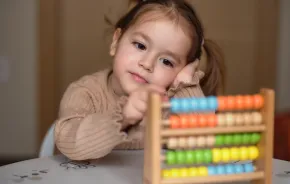Ah, the good old days of making a buck, kid-style: Set up the card table on the front lawn, have Mom mix the Western Family lemonade (contains no fruit juice), charge 10 cents for 3 ounces and collect enough change to buy half a G.I. Joe.
Today’s kids, however, have needs beyond an oversized man-doll with lifelike hair and kung-fu grip. High-end athletic shoes and cutting-edge electronics are considered vital accoutrements for many First World youngsters. So how can parents teach children good money habits when we ourselves don’t always follow sound financial principles?
A good place to start is “Moneyville,” a new exhibit opening Sept. 15 at The Children’s Museum, Seattle. Whether your 3- to 10-year-old is a future captain of industry or WTO rioter, there’s something in “Moneyville” to tantalize her intellect and engage her curiosity. And it all revolves around the seemingly dry topics of currency, global trade, investing, saving, spending and money management.
The Federal Reserve Board reports that consumer debt is now a record $2.17 trillion and that, for the first time in history, we now owe more than we make. So why teach children about money when it’s us, the parents, who need the help? For the same reason we force-feed them kale: Good habits start early. According to the Institute of Consumer Financial Education, a San Diego-based nonprofit dedicated to helping people spend wisely, we should introduce our children to money as soon as they can count.
And while the ICFE prescribes dull learning exercises such as unit price comparisons, “Moneyville” puts the fun into learning about dollars and cents. “I am absolutely thrilled to have this exhibit,” says Chief Executive Officer K.C. Gauldine. “There isn’t a lot out there in regards to financial literacy that’s really fun and exciting for kids of all ages. I think “Moneyville” is very exciting for families because they are trying to teach their younger children what money is all about … especially in this region, with its strong economy.”
The highly interactive exhibit boasts 6,000 square feet of micro- and macro-economics, specially designed for the microconsumer. Start in the Money Factory, which explores everything from how money is made to how it evolved. (Early on, large stones were considered legal tender. Money has never grown on trees, but it has tumbled down mountains.) Kids can also peer through a video microscope at the hidden security features of U.S. currency.
To Market, To Market gives children an understanding of markets, prices, supply and demand. There’s a faux stock market to test your investing savvy over a year of trading. See how global events such as social upheaval in a distant textile-producing nation can affect your stock portfolio. To Market also features a mock grocery store that links to financial literacy. Here too, the focus is on having fun while learning everyday concepts around earning and spending money. “It’s not just a play area,” says Director of Exhibits Patrick Roush. “It brings the idea that everything has value: OK, I’ve put in a day of work and now I can buy food. What is that link between work and money?”
The Global Trade exhibit has an area called “The Shirt Off Your Back” where you can learn where your own clothing was made. That ties into how that garment got from there to your local mall, and how trade leads to economic growth. The younger set can get their hands on the controls of a kid-size crane and load crates onto “cargo ships” destined for Canada, Mexico or Japan.
Other areas include The Bank, a look at how the economy operates, and Dollars and Sense, which features everyday money management concepts. Each exhibit has several substations that draw in kids of various ages. “‘Moneyville’ is perfect for school-age children, although there are a lot of parts that a 3-year-old can interact with,” says Juliet Torres, the museum’s director of education. “It has some pretty complex, abstract displays to challenge older kids, and at the same time a younger child can be in the bank and play with oversized coins. There are interactive pieces for younger kids and thinking pieces for the older children.”
And, in a nod to good old days, there’s even a lemonade stand. Except here it’s virtual and the proprietor must estimate profits and losses based upon the cost of lemons and the weather forecast. Doing it the old-fashioned way had its charms, but not enough to buy an Xbox.
Derek Blaylock lives in Seattle with his wife and two young sons.
Resources
Institute of Consumer Financial Education www.financial-education-icfe.org/default.asp
The Money Camp, a nonprofit organization that supplies kids, parents and teachers with information that leads to financial independence. www.themoneycamp.com/index.php
Washington Mutual Bank, the sponsor of “Moneyville,” offers WaMoola for L.I.F.E. (Lessons in Financial Education), which supplies lessons for every grade level. Lessons are grade- and age-appropriate and cover various financial topics in easy-to-understand terms. See www.wamu.com/about/community/programspartnerships/education.asp for information.
Money Smart Kids, free financial workshops for parents and kids ages 7-11, are offered this fall at the following YMCAs of Greater Seattle: Bellevue, Highline and Sammamish. For more information, visit www.seattleymca.org.
GO
The Children’s Museum, Seattle
Located in the lower level of the Center House, Seattle Center
206-441-1768,
www.thechildrensmuseum.org
Admission $7.50, grandparents $6.50, under 1 free
“Moneyville” runs Sept. 15-Jan. 13, 2008









